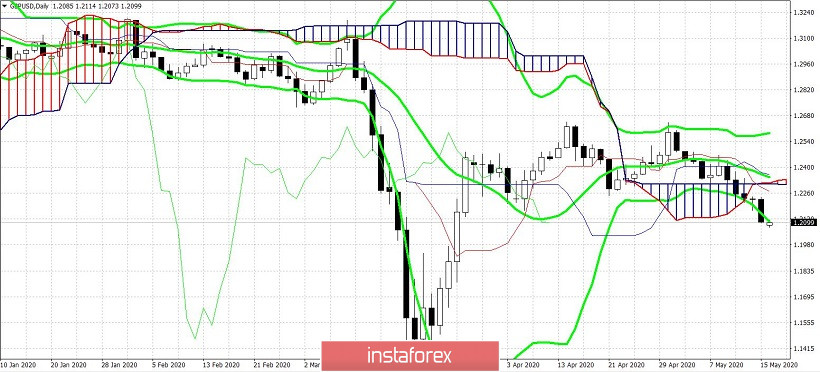The pair is located at the levels of two-month lows and is testing the 20th pattern. The British pound remains under pressure. Even the relative vulnerability of the US dollar does not allow the GBP/USD bulls to organize a more or less large-scale correction.
At the end of the weekend, the greenback depreciated throughout the market as dollar bulls reacted negatively to the debate over a $3 trillion additional assistance bill to the US economy. Let me remind you that the Democrats managed to approve this document in the House of Representatives, where they control the majority. Under the bill, a trillion dollars is to be allocated to state and local governments, including new direct payments to individuals, and financial aid to the unemployed, tenants and homeowners. However, representatives of the Democratic Party met with fierce criticism from the Republicans even in the lower house of parliament. They believe that Washington has already allocated enough funds to support the economy, while the initiative of the Democrats is just promotion of their party, especially in light of the upcoming presidential election. Republicans made it clear that the bill has no chance in the Senate. The White House also criticized the document hinting that Trump would not sign it, even if it got the approval of the Upper House of Parliament. In addition, Fed's Chairman Jerome Powell insisted on the adoption of an additional assistance package last week. As a result the greenback came under pressure.

The GBP/USD pair ignored these events and the weakening of the greenback did not affect positions of the British pound. On the contrary, the pound started the trading week with a small downward gap. On Friday, the trading ended at 1.2103, while on Monday the market opened at 1.2085. It happened due to several fundamental factors.
Firstly, traders are still affected by the latest macroeconomic releases that were published last week. Let me remind you that in the first quarter, the UK's GDP fell by 2% in quarterly terms and by 1.6% in annual terms. Even though experts anticipated a worse result (-2.6% q/q -2.1% y/y), this was the largest drop over the past 11 years. Consumer spending decreased by 1.7% compared to the previous quarter. Last time it happened at the end of 2008. Meanwhile, industrial production collapsed by 4.2% m/m. It was the sharpest decline since January 1971.
Secondly, traders reacted negatively to the data of the parliamentary report which was published by The Sun. According to the report, supporters of European integration are now putting strong pressure on Boris Johnson to approve the extension of the transition period for another two years since the parties obviously do not have time to agree on all points of a large-scale trade deal between London and Brussels amid the pandemic. Meanwhile, according to the same report, such a prolongation can be very expensive. Economists believe that if the transition period is postponed for another two years, the costs of the UK's withdrawal from the EU may increase ten times including obligatory payments to the EU budget (11 billion pounds per year), losses from unregulated exit from the free trade zone, bureaucratic costs, uncontrolled migration and obligations to save subsidized budgets in the eurozone.
Britain's total losses could rise to five trillion pounds in the worst-case scenario. Given the extremely negative consequences of the epidemic for the British economy, such projected financial losses have led to a fall of the British pound, including the GBP/USD pair. According to another report, published by the Daily Telegraph, the crisis this year forms a 340 billionth hole in the state budget (this is more than a third of the total budget). In the less optimistic scenario, if the quarantine continues or the second wave of the epidemic occurs, the deficit of the British budget may amount to more than half a trillion pounds in the fiscal 2020-2021 year. Such huge losses amid the lack of progress in the negotiations between London and Brussels also put significant pressure on the GBP/USD pair.
Thus, the general fundamental background for the pair is extremely negative. The news from the coronavirus front provided little support to the pound. On Sunday, the UK recorded the lowest mortality rate from the coronavirus. However, the number of deaths on weekends is often lower than during the week due to the specifics of reporting. Therefore, this factor had a weak effect on the dynamics of the pair. All this speaks about the advantages of short positions for the GBP/USD pair.

From the technical point of view, the pair on the daily chart is located on the lower line of the Bollinger Bands indicator which also indicates the priority of the downward movement. The pair shows a clear bearish trend which is confirmed by the main trend indicators such as Bollinger Bands and Ichimoku. The downward trend formed the strongest bearish Line Parade signal on all of the above time frames. On D1, all indicator lines are above the price chart demonstrating pressure on the pair. In order to determine the main downward target, let's take a look at the weekly time frame. It is better to focus on the Tenkan-sen line which is the price of 1.2030. It is important to be extremely careful with sell deals at the very base of the 20th pattern as the bears may not have enough strength to lower the price to the 19th price level.





















